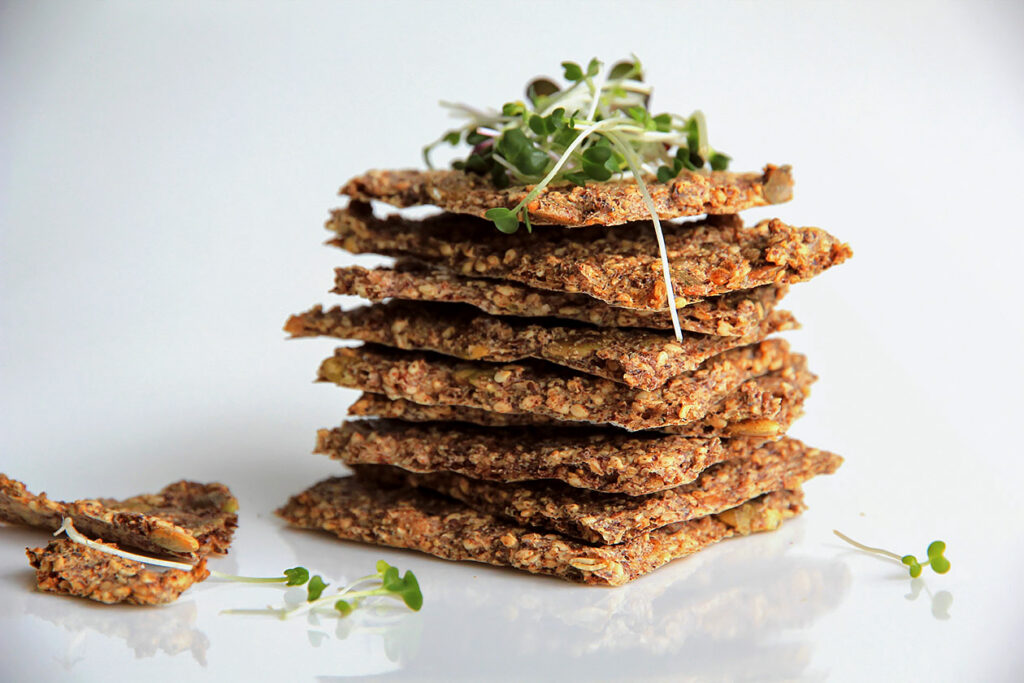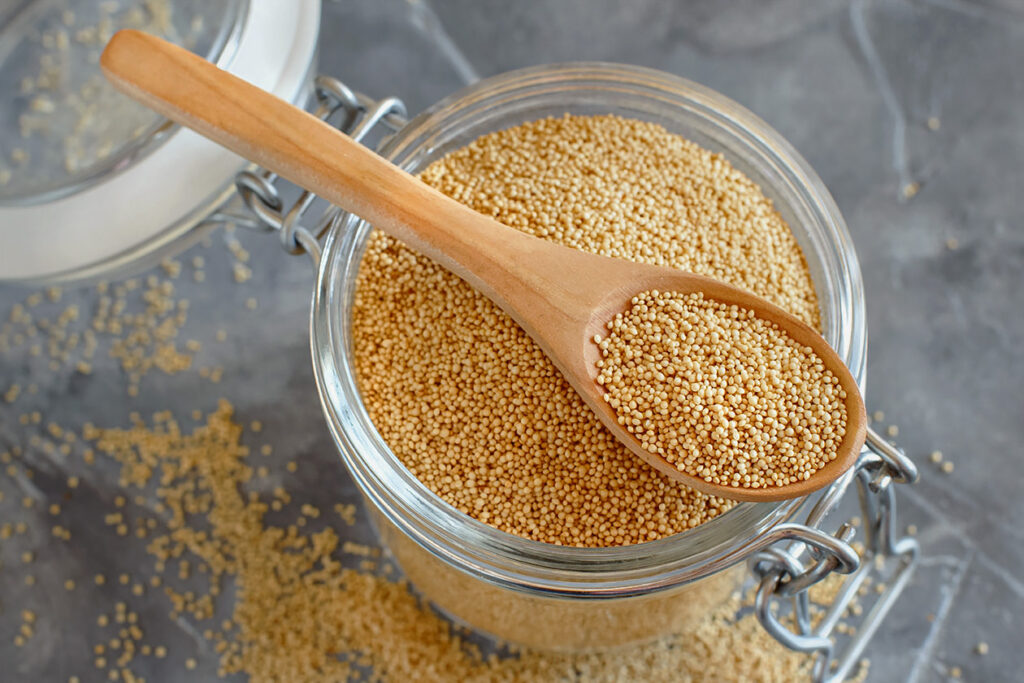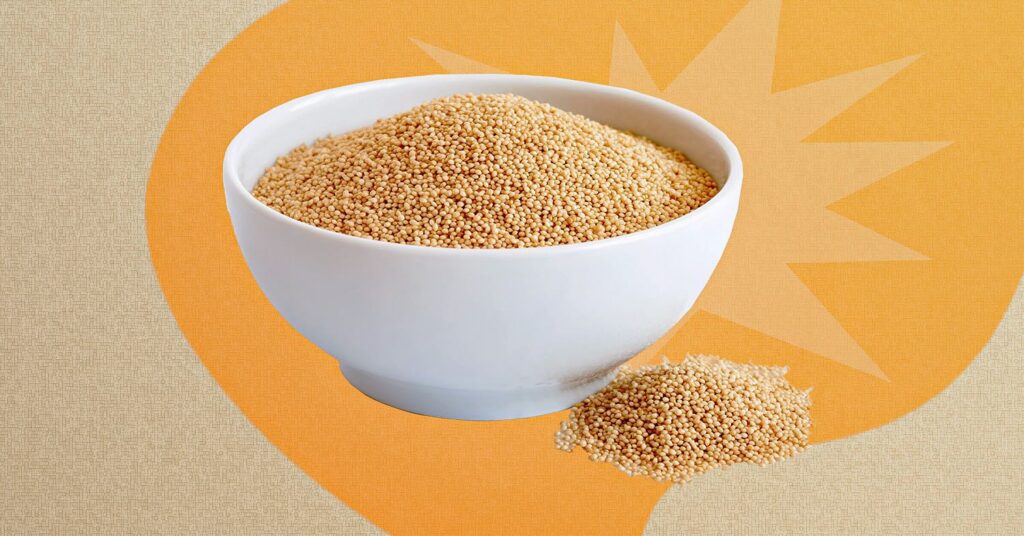Love grains, but want to go beyond grain bowls? If you’ve been curious about quinoa, dabbled in buckwheat, or tested the millet waters, amaranth is the next stop on your culinary conquest. Versatile and easy to cook, amaranth is delicious in sweet and savory porridges, fritters, salads, snacks, and much more. Learn how to cook amaranth in a wide variety of sweet and savory applications for a flavorful, extra-nutritious spin on your favorite recipes.
What is amaranth?
Amaranth is an ancient grain-like seed that’s high in protein, low in fat, gluten-free, and perfect for expanding your knowledge of ancient grain-like seeds (also known as pseudograins). Beyond producing this delicious, nutrient-dense food in astounding volume—a single plant can produce an entire cup of seeds or more—amaranth itself is an eye-catching ornamental addition to your summer garden. It sprouts beautiful feathery beet-red plumes atop towering red stalks, flocked by edible green leaves reminiscent of kale.
Some varieties, like elephant head amaranth, produce a tight, bulbous cluster of plumes shaped like its namesake, stretching its trunk high in the air. Amaranth seeds themselves are frankly adorable, reminiscent of pale golden nonpareil sprinkles or miniature quinoa.

Amaranth history
Native to North and Central America, amaranth played an important role in early civilizations, both in sustenance and cultural symbolism. Aztecs would use amaranth in a range of rituals, including sculpting deities from a pliable mixture of amaranth seeds and honey, letting them dry, then breaking them apart and distributing the shards to eat (a kind of predecessor to the granola bar). Amaranth was also a staple crop among Native American tribes, with its seeds and leaves consumed, and its plumes used for red textile and food dyes.
“50 tiny amaranth seeds multiply into a five-gallon bucket of billions of little bundles of potential. The ratios of expansion are mind-boggling,” says Rowen White of the Mohawk community of Akwesasne. A farmer, seed-keeper, activist, author, and founder of indigenous foods resource Sierra Seeds, White has dedicated her career to spreading knowledge of native cultivation traditions. “When we witness the generous and ever-nourishing patterns of the cycles of seed life,” says White, “we are reminded again that the foundations of life are rooted in abundance.”
What does amaranth taste like?
Amaranth tastes nutty, earthy, and slightly sweet, with hints of black pepper and subtle “rooty” vegetal flavor notes like beet and carrot. This profile lends itself to versatility, which makes amaranth delicious in everything from hearty breakfast dishes and salads like tabbouleh, to simple baked goods, smoothies, and more. Ready to learn how it’s done?
How to cook with amaranth (9 recipe ideas)
Porridge it
Amaranth cooks into a soft, luscious sweet or savory porridge, like polenta but with a much denser volume of nutrients, especially protein. Simmer in water or plant-based milk until tender (about 30 minutes), drain off excess liquid if necessary, and flavor or garnish as desired.
Pop it
You can pop amaranth like popcorn for teeny-tiny (again, adorable) popped grains that make a delicious crunchy garnish for soups and salads. Heat a pot with high sides over medium heat, then add a heaped tablespoon or so of amaranth straight in. Don’t cover the pot, as the grains are too small and will just steam. Once they start popping, a few will fly out of the pot—a more or less inevitable occurrence. Continue the process in batches until you have the amount of popped amaranth you want, then go hunting for errant grains on the floor.
Make candy
Once you’ve popped it, spread it out evenly in a single layer over a parchment-lined baking sheet, add in extras like cacao nibs or chopped nuts if you like, then pour melted chocolate over it to cover. Chill until set, then break into bark or cut into rectangles for crispy-crunchy candy bars that seriously satisfy. You can also mix the popped amaranth with melted chocolate and set it in a mold to make some super fun candy.

Blend it
Amaranth seeds are an easy way to add nutrients to smoothies. They integrate well in a high-powered blender, and pair seamlessly with all your favorite smoothie ingredients. Try toasting them in a hot dry pan first to add a nutty flavor.

Fritter it
Amaranth crisps and browns beautifully, so make it the star of savory fritters perfect for using up the vegetables in your fridge. Mix a cup of amaranth seeds with two eggs (or egg replacer equivalent), add in a cup of sliced leafy greens or grated vegetables, a chopped scallion and minced garlic clove, a squeeze of fresh lemon juice, and salt and pepper to taste. Form patties and shallow-fry in hot oil for crunchy, hearty fritters you’ll make over and over.
Crust it
Amaranth is delicious in any kind of crust, whether you’re making crunchy, amaranth-crusted tofu or a sweet and savory pie with an amaranth crust. Substitute a quarter of the flour (or other crust element) in your recipe with toasted amaranth seeds or a mix of half toasted ground amaranth and half seeds. The result is a nutrient-dense coating or pie base that adds welcome flavor and texture.

Make bars
Take a leaf out of the Aztecs’ book and combine amaranth seeds and honey with your favorite granola ingredients—nuts, dried fruit, other seeds and grains, baking spices—press into a baking sheet, chill, and cut into bars for a turbocharged breakfast or snack on the go.

Make crackers
Add crunch and nutty, toasty flavor to homemade crackers by adding amaranth and your other favorite seeds to the dough. Amaranth is delicious paired with fresh herbs—toss in a little chopped rosemary or sage for extra zip.
Add it to pancakes
Fortify your morning pancakes and add extra texture by whisking a quarter-cup of amaranth seeds into two cups of batter. You can also make pancakes with amaranth flour (found in health food stores or made in your blender from toasted seeds) for a nutritional boost.

How to Take Care of Amaranth
Store amaranth in a container with a tight-fitting lid and store in a cool, dark place like a pantry. The temperature at which it’s stored will have a significant impact on its shelf life (typically four to six months). Keeping the container in a cabinet near the stove may shave a month or two off its freshness.
How do you know when amaranth has started to spoil? Amaranth that’s past its prime will start to darken in color, from white or light beige to dark gold or brown, and may have a bitter flavor. Stash it in the freezer to extend its life for up to a year, but try your best to finish it before then, because unlike some dry pantry staples—we’re looking at you, beans and pulses—amaranth isn’t ideal for long-term storage.
Our “How the F@#! Do I Cook With” series explores the mouthwatering, practical, awe-inspiring, and infuriating qualities of kitchen ingredients. What ingredient has you stumped? Write to us at editorial@livekindly.com with the subject line “How Do I Cook With” and then name your ingredient!


